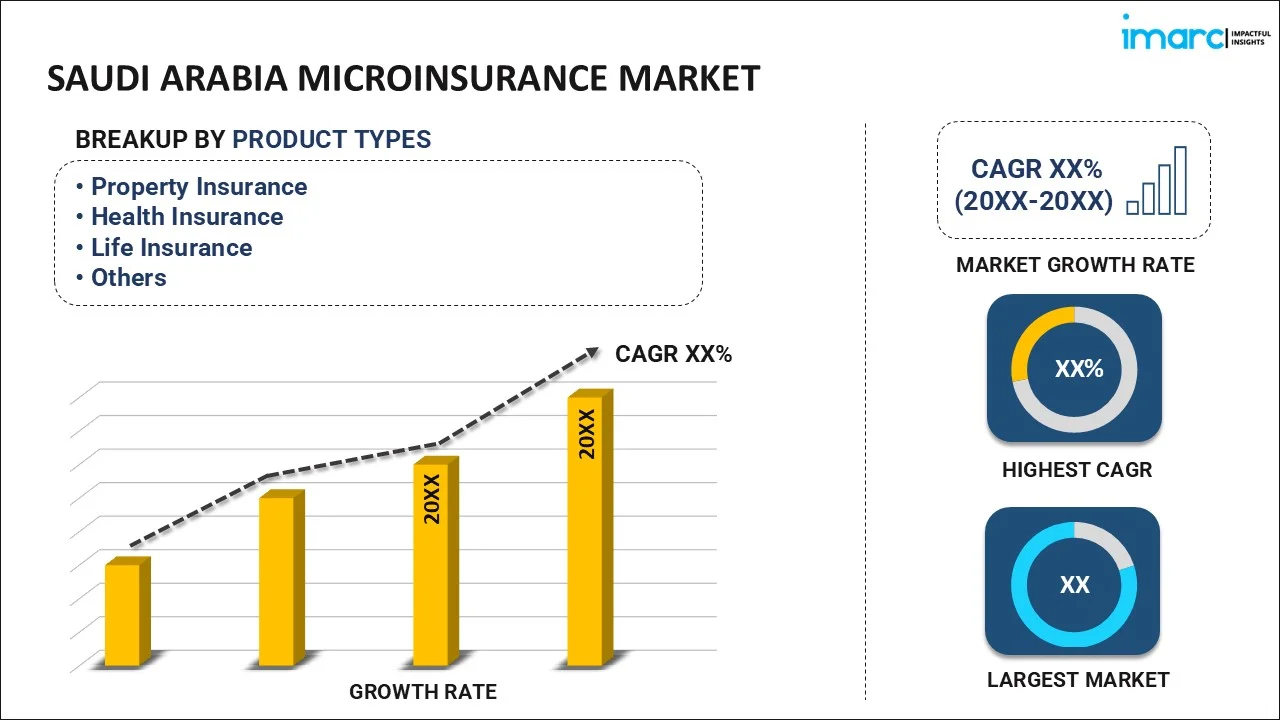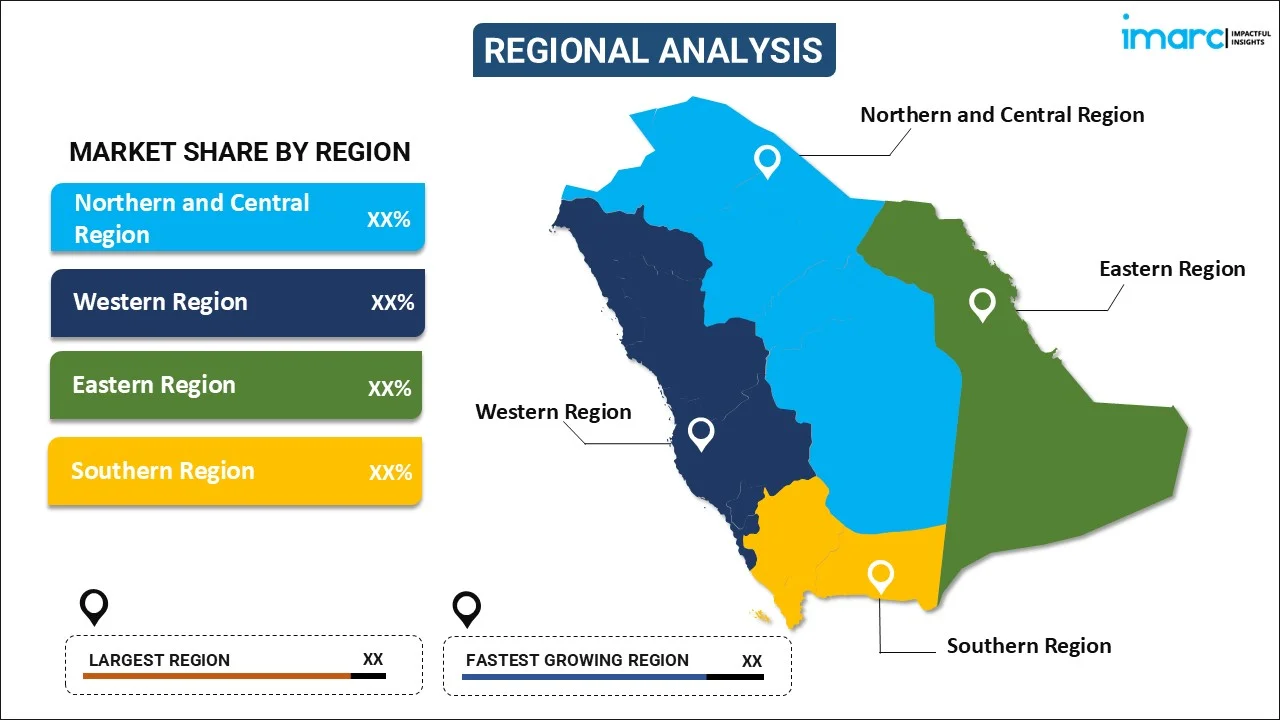
Saudi Arabia Microinsurance Market Size, Share, Trends and Forecast by Product Type, Provider, Model Type, and Region, 2026-2034
Saudi Arabia Microinsurance Market Overview:
The Saudi Arabia microinsurance market size reached USD 937.7 Million in 2025. Looking forward, IMARC Group expects the market to reach USD 1,874.3 Million by 2034, exhibiting a growth rate (CAGR) of 8.00% during 2026-2034. The market is gradually expanding, driven by government efforts to promote financial inclusion and serve low-income populations. Regulatory support and public awareness campaigns further strengthen this sector. With economic diversification, microinsurance is poised to support financial security, making it a key element in Saudi Arabia's evolving insurance landscape.
|
Report Attribute
|
Key Statistics
|
|---|---|
|
Base Year
|
2025 |
|
Forecast Years
|
2026-2034
|
|
Historical Years
|
2020-2025
|
| Market Size in 2025 | USD 937.7 Million |
| Market Forecast in 2034 | USD 1,874.3 Million |
| Market Growth Rate (2026-2034) | 8.00% |
Saudi Arabia Microinsurance Market Trends:
Increasing Regulatory Support
Government efforts to boost financial inclusion are central to the development of microinsurance, which targets low-income populations. These initiatives focus on encouraging insurance providers to design accessible, affordable products that address the specific needs of underserved groups. Regulatory frameworks are evolving to support this growth, with policies aimed at balancing market expansion with consumer protection. This includes setting guidelines that promote transparency, fair practices, and easy-to-understand terms, which help build trust among potential customers. By fostering an environment that supports microinsurance, the government is also aiming to establish market stability, ensuring that insurers maintain adequate risk management practices. For instance, in October 2023, Saudi Arabia’s Health Ministry announced plans for a comprehensive state-funded health insurance program for all citizens by mid-2024. Key features include lifetime coverage without annual renewal and no approval requirements. Such regulatory backing is pivotal in promoting confidence in microinsurance products, enabling broader financial security and risk protection for individuals who might otherwise lack such safeguards. Additionally, the involvement of the private sector in these efforts is expected to drive innovation and expand the range of microinsurance products available, tailored to diverse risks and financial capacities. As the health insurance program gains traction, it sets a precedent for similar initiatives in other insurance areas, potentially fostering a robust microinsurance ecosystem.
Economic Diversification and SME Growth
Saudi Arabia's economic diversification efforts are driving the expansion of small and medium-sized enterprises (SMEs), creating a fertile market for microinsurance. As the nation shifts focus from its traditional oil-based economy, sectors like technology, tourism, and manufacturing are seeing increased investment and growth, resulting in a rise in SME formation. According to industry reports, Saudi Arabia has over 300,000 small and medium enterprises (SMEs) that exhibit a crucial role in the economy. These SMEs contribute 35% to the Gross Domestic Product (GDP) and provide approximately 25% of private sector employment. This boom in SMEs not only fuels job creation but also highlights the need for financial security measures tailored to these businesses and their workforce. Microinsurance products cater directly to this need by offering affordable, accessible insurance solutions that help SMEs manage risks related to health, property, and business continuity. These offerings support entrepreneurs and employees alike, helping them stabilize financially in the face of unexpected setbacks. As SMEs grow in influence within the Saudi economy, the demand for specialized microinsurance products will likely continue to increase, strengthening both financial inclusion and economic resilience.
Saudi Arabia Microinsurance Market Segmentation:
IMARC Group provides an analysis of the key trends in each segment of the market, along with forecasts at the country level for 2026-2034. Our report has categorized the market based on product type, provider, and model type.
Product Type Insights:

- Property Insurance
- Health Insurance
- Life Insurance
- Index Insurance
- Accidental Death and Disability Insurance
- Others
The report has provided a detailed breakup and analysis of the market based on the product type. This includes property insurance, health insurance, life insurance, index insurance, accidental death and disability insurance, and others.
Provider Insights:
- Microinsurance (Commercially Viable)
- Microinsurance Through Aid/Government Support
A detailed breakup and analysis of the market based on the provider have also been provided in the report. This includes microinsurance (commercially viable), and microinsurance through aid/government support.
Model Type Insights:
- Partner Agent Model
- Full-Service Model
- Provider Driven Model
- Community-Based/Mutual Model
- Others
A detailed breakup and analysis of the market based on the model type have also been provided in the report. This includes partner agent model, full-service model, provider driven model, community-based/mutual model, and others.
Regional Insights:

- Northern and Central Region
- Western Region
- Eastern Region
- Southern Region
The report has also provided a comprehensive analysis of all the major regional markets, which include Northern and Central Region, Western Region, Eastern Region, and Southern Region.
Competitive Landscape:
The market research report has also provided a comprehensive analysis of the competitive landscape. Competitive analysis such as market structure, key player positioning, top winning strategies, competitive dashboard, and company evaluation quadrant has been covered in the report. Also, detailed profiles of all major companies have been provided.
Saudi Arabia Microinsurance Market News:
- In November 2024, Chhaya announced its expansion across Middle East through a strategic collaboration with Monak e-Services to provide microinsurance services across Saudi Arabia and Oman for migrant workers.
- In September 2024, Hakbah, a Saudi Arabia-based fintech firm specializing in digital savings, and Tawuniya, a prominent insurance provider across Saudi, announced collaboration to transform the saving experience by offering extensive life insurance coverage.
Saudi Arabia microinsurance Market Report Coverage:
| Report Features | Details |
|---|---|
| Base Year of the Analysis | 2025 |
| Historical Period | 2020-2025 |
| Forecast Period | 2026-2034 |
| Units | Million USD |
| Scope of the Report |
Exploration of Historical Trends and Market Outlook, Industry Catalysts and Challenges, Segment-Wise Historical and Future Market Assessment:
|
| Product Types Covered | Property Insurance, Health Insurance, Life Insurance, Index Insurance, Accidental Death and Disability Insurance, Others |
| Providers Covered | Microinsurance (Commercially Viable), Microinsurance Through Aid/Government Support |
| Model Types Covered | Partner Agent Model, Full-Service Model, Provider Driven Model, Community-Based/Mutual Model, Others |
| Regions Covered | Northern and Central Region, Western Region, Eastern Region, Southern Region |
| Customization Scope | 10% Free Customization |
| Post-Sale Analyst Support | 10-12 Weeks |
| Delivery Format | PDF and Excel through Email (We can also provide the editable version of the report in PPT/Word format on special request) |
Key Questions Answered in This Report:
- How has the Saudi Arabia microinsurance market performed so far and how will it perform in the coming years?
- What is the breakup of the Saudi Arabia microinsurance market on the basis of product type?
- What is the breakup of the Saudi Arabia microinsurance market on the basis of provider?
- What is the breakup of the Saudi Arabia microinsurance market on the basis of model type?
- What is the breakup of the Saudi Arabia microinsurance market on the basis of region?
- What are the various stages in the value chain of the Saudi Arabia microinsurance market?
- What are the key driving factors and challenges in the Saudi Arabia microinsurance market?
- What is the structure of the Saudi Arabia microinsurance market and who are the key players?
- What is the degree of competition in the Saudi Arabia microinsurance market?
Key Benefits for Stakeholders:
- IMARC’s industry report offers a comprehensive quantitative analysis of various market segments, historical and current market trends, market forecasts, and dynamics of the Saudi Arabia microinsurance market from 2020-2034.
- The research report provides the latest information on the market drivers, challenges, and opportunities in the Saudi Arabia microinsurance market.
- Porter's five forces analysis assist stakeholders in assessing the impact of new entrants, competitive rivalry, supplier power, buyer power, and the threat of substitution. It helps stakeholders to analyze the level of competition within the Saudi Arabia microinsurance industry and its attractiveness.
- Competitive landscape allows stakeholders to understand their competitive environment and provides an insight into the current positions of key players in the market.
Need more help?
- Speak to our experienced analysts for insights on the current market scenarios.
- Include additional segments and countries to customize the report as per your requirement.
- Gain an unparalleled competitive advantage in your domain by understanding how to utilize the report and positively impacting your operations and revenue.
- For further assistance, please connect with our analysts.
 Request Customization
Request Customization
 Speak to an Analyst
Speak to an Analyst
 Request Brochure
Request Brochure
 Inquire Before Buying
Inquire Before Buying




.webp)




.webp)












